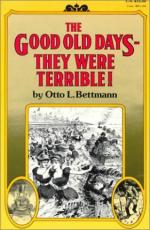
|
| Name: _________________________ | Period: ___________________ |
This test consists of 15 multiple choice questions and 5 short answer questions.
Multiple Choice Questions
1. What people took advantage of the tenants in the time after the Civil War?
(a) The landlords.
(b) The police.
(c) The merchants.
(d) The immigrants.
2. What was the fare for the electric trolley car in the late 1800s?
(a) Twenty-five cents.
(b) Five cents.
(c) Ten cents.
(d) One cent.
3. According to Bettmann in "Rural Life," what frontier necessity was often a cesspool of contamination?
(a) The outhouse.
(b) Nearby streams.
(c) The local well.
(d) The barn.
4. In "Air," what was a common misconception about air pollution?
(a) That it created envy in nations overseas.
(b) That it helped horticulture.
(c) That it attracted business.
(d) That it cured ailments.
5. What was a major contributor to the contamination and disease in the wells in the late 19th century?
(a) Drainage from the outhouse.
(b) Food left out.
(c) Typhoid epidemic.
(d) Misunderstanding of germs.
6. What area in New York City had an abundance of industrial factories in the early 19th century ?
(a) Hunter's Point.
(b) New York City.
(c) Lower East side.
(d) Chelsea.
7. In the time after the Civil War, humans generated an amazing amount of:
(a) Textiles.
(b) Trash.
(c) Ingenuity.
(d) Offspring.
8. In the late 19th century, at what age were most workers forced to stop working due to health problems?
(a) Fifty-five.
(b) Fifty.
(c) Forty-five.
(d) Forty.
9. Women on the frontier in the late 1800s also endured the hard work of what daily chore?
(a) Cooking.
(b) Sewing.
(c) Chicken care.
(d) Laundry.
10. What was the name of the first vertical apartments?
(a) The New Yorker.
(b) Lakeside Apartments.
(c) Park Place.
(d) Stuyvesant Apartments.
11. What kind of work did the young rural girls often find in the cities in the late 1800s?
(a) Selling door to door.
(b) Servant help.
(c) No work was to be found.
(d) In the sweatshops.
12. Where was the El Train introduced?
(a) Atlanta.
(b) Boston.
(c) Chicago.
(d) New York.
13. What did Bettmann cite as the main reason for the traffic problems in the cities in the late 1800s?
(a) Unpaved roads.
(b) Too many one-way streets.
(c) Prevalence of the horse and cart.
(d) Unsynchronized traffic lights.
14. What was the biggest safety threat in the vertical apartments in the late 1800s?
(a) Unsafe water.
(b) Earthquakes.
(c) Lead poisoning.
(d) Fire.
15. According to Bettmann in "Rural Life," why would many young girls leave the country for the promise of the city?
(a) They thought they could find husbands easier in the city.
(b) They watched their mothers grow prematurely old with toil.
(c) They would be sent to earn a wage to help the family.
(d) Their families could no longer afford to feed them.
Short Answer Questions
1. Why did tenants in the late 1800s have such big problems when it came to housing in the big cities?
2. Who was A.T. Stewart?
3. According to Bettmann, what percentage of New Yorkers lived in the slums between 1868 and 1875?
4. What work did an ancient stove require on the frontier?
5. In what year was the El Train introduced?
|
This section contains 508 words (approx. 2 pages at 300 words per page) |

|




